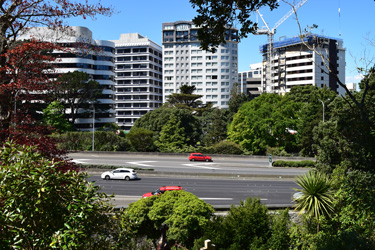Beyond beautification - roadside planting
There’s no doubting that plants beautify roadsides, breaking up masses of concrete, steel and unsightly road tar. With so much being spent on roading, some people may suggest that plants are just another cost that could be avoided! But plants save money in the long-term as this article will explain…
Plants should be considered a critical element of road development planning. When properly laid out (spaced) and suitable high quality plants are selected, roadside plantings will perform four key functions…
- Manage water run-off. Plants slow, absorb and clean the water that runs off streets and motorways, resulting in reduced soil erosion (as opposed to an unplanted grass bank), minimising the risk of flooding and cleaning the water supply.
- Natural barriers – roadside plantings serve as living fences, catching and absorbing wild weather, in doing so lessening the impact on travellers.
- Noise protection – established trees absorb traffic noise lessening the impact on neighbouring properties.
- Provide pollinator habitat – the right selection of trees attracts and provides habitat for the pollinators needed to help grow nearby crops, fruits and vegetables.
Traffic jams are stressful experiences often leading to bad driving choices and hence accidents. A simple solution is to increase roadside plantings! Research suggests plants and trees give off endorphins which make people happier and more relaxed. Furthermore trees muffle ambient sound which could be handy to cover up the expletive filled road rage that’s becoming more commonplace.
As with most development, cost is a major consideration. Whilst native trees, shrubs and flaxes may cost more they are worth the investment. Natives are typically better suited to the climate and growing conditions, meaning they are more likely to grow bigger and stronger. Using natives will also provide our endemic birds and insects with more habitats to forage and breed.
Earlier this year work commenced on one of the largest planting exercises ever seen in New Zealand along the Kapiti Expressway. Over 1.3 million native plants will be planted over 150 hectares of land.
"It is more than just an expressway. We want to create a scenic drive, a shared pathway and an enduring corridor of plant life. The work will improve the local biodiversity and ecological connections on the Kapiti Coast, helping flora and fauna to thrive," NZTA’s Neil Walker said.
MacKays to Peka Peka (M2PP) Alliance project manager Alan Orange added "We also expect to see our local bird, lizard and native fish populations grow as a result of the landscaping and planting work.”
So with all these benefits roadside planting has to offer perhaps it’s time to park the new flag design and spend the $26 million on planting roadsides. Roadside planting is guaranteed to provide a healthier, happier New Zealand. Not to mention the jobs it would provide and the increased business for plants growers.

16-Sep-2015


